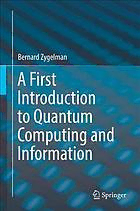
A first introduction to quantum computing and information PDF
Preview A first introduction to quantum computing and information
Bernard Zygelman A First Introduction to Quantum Computing and Information A First Introduction to Quantum Computing and Information Bernard Zygelman A First Introduction to Quantum Computing and Information 123 BernardZygelman DepartmentofPhysicsandAstronomy UniversityofNevada LasVegas,NV,USA ISBN978-3-319-91628-6 ISBN978-3-319-91629-3 (eBook) https://doi.org/10.1007/978-3-319-91629-3 LibraryofCongressControlNumber:2018946528 ©SpringerNatureSwitzerlandAG2018 Thisworkissubjecttocopyright.AllrightsarereservedbythePublisher,whetherthewholeorpartof thematerialisconcerned,specificallytherightsoftranslation,reprinting,reuseofillustrations,recitation, broadcasting,reproductiononmicrofilmsorinanyotherphysicalway,andtransmissionorinformation storageandretrieval,electronicadaptation,computersoftware,orbysimilarordissimilarmethodology nowknownorhereafterdeveloped. Theuseofgeneraldescriptivenames,registerednames,trademarks,servicemarks,etc.inthispublication doesnotimply,evenintheabsenceofaspecificstatement,thatsuchnamesareexemptfromtherelevant protectivelawsandregulationsandthereforefreeforgeneraluse. Thepublisher,theauthorsandtheeditorsaresafetoassumethattheadviceandinformationinthisbook arebelievedtobetrueandaccurateatthedateofpublication.Neitherthepublishernortheauthorsor theeditorsgiveawarranty,expressorimplied,withrespecttothematerialcontainedhereinorforany errorsoromissionsthatmayhavebeenmade.Thepublisherremainsneutralwithregardtojurisdictional claimsinpublishedmapsandinstitutionalaffiliations. ThisSpringerimprintispublishedbytheregisteredcompanySpringerNatureSwitzerlandAG Theregisteredcompanyaddressis:Gewerbestrasse11,6330Cham,Switzerland ForJudith Foreword This book is an excellent introduction to the exciting and rapidly developing field of Quantum Computing and Information. It is well suited to senior undergraduate students, working engineers, and scientists interested in acquiring a solid under- standingofthissubjectmatter.Thisbookisagoodstartingpointforthosewanting todeveloppracticalexperiencewiththeconceptualandmathematicaltoolsrequired formoreadvancedstudiesandforentry-levelparticipationinrelatedtheoreticaland experimentalresearch.Thebookiswellorganized,clear,andconcise,anditcovers themostrelevantintroductorytopicsinQuantumComputingandInformationtoday. Written in easy to understand prose, and with ample mathematical depth, this bookwillbeofgreatvaluetostudentswhowanttotakethefirststepinmastering this subject material. Emphasis is placed on core concepts, rather than historical developmentsandnarratives,andtheseconceptsaredevelopedthroughaseriesof relevant,in-textexamplesthatallowstudentstoworkthroughmathematicaldetails, step-by-step,withouthavingtodiverttheirattentiontoappendicesandarticlesinthe open literature. Each chapter is also accompanied by an equally well-designed set ofproblemsthatwillallowstudentstotesttheirnewknowledgeandincrementally hone their technical skills as they proceed from chapter to chapter. In addition, links are provided to web resources, including Mathematica notebooks, allowing readers to continue their exploration of this subject matter through numerical experimentationandvisualization. As a Ph.D. physicist and engineer working in this field, I appreciate the nature and content of this book, and the benefits students and working professionals will get by reading it. I have known Professor Bernard Zygelman for more than two decades. I have taken classes from him, have collaborated in research with him as an undergraduate, and have significantly benefited from numerous conversations withhimontopicswithinphysics.SoIamthrilledhehaswrittenthisbook,asIam sure it will benefit others. This book successfully captures Professor Zygelman’s vii viii Foreword knowledgeinQuantumComputingandInformationandhisengagingandeffective teaching style and methodology in a format that will now reach a much broader audience. Scottsdale,AZ,USA WilliamClark February2018 Ph.D.Physics Preface Motivation This monograph is an outgrowth of courseware developed and offered at UNLV toapredominantlyundergraduateaudience.Themotivationforthecourseand,by extension, this textbook is twofold. First, it is a response to the explosive growth and transformative technological promise of quantum computing and information (QCI) science. Second, for an introductory treatment, the requisite mathematical background is available to most students who have successfully digested the first year of university-level calculus. In contrast, a typical undergraduate quantum curriculum requires at least some exposure to the theory of partial differential equations, complex analysis, as well as advanced vector calculus. For this reason, many universities, including UNLV, expose students to the quantum theory in their junior and senior years. Quantum science is too important and relevant for its relegation to an upper-level offering. The material in this textbook should be accessible to most sophomores, and for AP students, freshman-level, physics, computerscience,andmathmajors.Thoughseveralexcellenttextsaredirectedtoan undergraduate audience,notablyN.DavidMermin’sQuantumComputerScience: An Introduction, Cambridge U. Press 2007, I have striven to make the material accessible to an entry-level cohort. To that end, the textbook includes numerous links to Wolfram Mathematica(cid:2)R notebooks that offer numerical demonstrations andexercisesthathelpilluminatedifficultandcounterintuitiveconcepts.Thelatter help guide the student, via an interactive approach, through the written material onthepage.Concedingrigorinfavorofaccessibility,Ihopetopiquetheinterestof studentsinthisnovel,dynamic,branchofphysicsandcomputerscience.Successful completionofitshouldprimestudentsforadvancedstudyandhelpfacilitatetheir explorationofleading-edgedevelopmentsinthecurrentliterature. ix x Preface Scope The modern quantum theory, one of the grand achievements of twentieth century science, will soon be celebrating its 100th anniversary. Estimates show that as much as 40% of the American GDP is owed to technologies whose foundational underpinning is provided by that theory. A discipline celebrating its centennial is expectedtobematureandwellvetted.Indeed,Iknowofnoexperimentaldatathat has undermined or contradicted the basic tenets of the theory codified in the mid- 1920s. Arguably, it is one of the most robust and fecund scientific paradigms ever advanced.Therefore,itissurprisingthatittookalmostthree-quartersofacentury of gestation for the novel insights and potential technological rewards offered by QCItobecomewidelydisseminatedandacceptedinthegreatercommunity.David Kaiserpresentsprovocativeinsightsonthatquestioninhisengagingsocialscience treatise,HowtheHippiesSavedPhysics:Science,Counterculture,andtheQuantum Revival,Norton2011.Regardless,thedaysof“shut-upandcalculate”areover,and itisimperativethatourundergraduatequantumcurriculumkeepspacewithcurrent developments. In the first two chapters, I introduce the foundational framework for the Copenhagen interpretation of quantum mechanics as it applies to qubit systems. I discuss the Dirac bra-ket notation and the tools necessary to manipulate objects inamulti-qubitHilbertspace.Chapter3reviewsthecircuitmodelofcomputation and I introduce the first quantum gates and circuits. Chapter 4 provides a detailed discussionoftheShorandGroveralgorithms.Chapters5and6areconcernedwith aspectsofquantuminformationtheory.Chapter9dealswiththetheoryofquantum error correction; the chapters mentioned above constitute a reasonably paced 14- week semester introduction to QCI. In my experience, I found that students are also curious of recent developments in quantum hardware, the guts of a quantum computer.Unfortunately,exceptNielsenandChuang’sQuantumComputationand QuantumInformation,CambridgeU.Press(2010),fewtextbookscoverthisaspect in detail. For that reason, I included Chap.7 and 8 which cover developments in trapped ion, quantum cavity electrodynamics (CQED), and quantum circuit (cQED) computers. That discussion proved challenging because a comprehensive treatment requires an advanced understanding of atomic physics, quantum optics, and many-body physics. Nevertheless, I believe that I succeeded in conveying the essential features of those paradigms by using models that require only a passing familiarity with differential equations and complex analysis. In an introductory course,thosechapterscouldbebypassed.Ihavealsoavoidedadetaileddiscussion ofcomputationalcomplexity,universality,andmeasurementtheory.Themotivated studentwhocompletesthecourseworkwillbeabletoaccesstheseadvancedtopics inNielsenandChuang’scomprehensivetreatment. Preface xi On Notation Iuseaconvention,commonamongphysicist,forlabelingstatesinmulti-qubitkets thatdiffersfromthatusedinmanyQCItexts.Givenket|abc(cid:3),Irefertotheentrycas thefirstqubit,bthesecond,andathethirdqubit.Forthecorrespondingbravectors, thatorder(fromrighttoleft)isinverted.Thisconventionalsoleadstoanotational adjustment in wire diagrams. With the convention used in this monograph (in alignmentwithMermin’stext),thefirstqubitcisplacedonthelowestrungofawire diagram, with the second and third, etc. qubit states stacked on it. I employ arrow notationtolabelvectorquantitiesanduseboldfaceformostoperators.Forcommon, such as the Pauli, operators where there is little chance of misunderstanding I use regulartypeface.InmostQCIliteratureoperatorsaresynonymouswiththeirmatrix representations, and so I make little effort to distinguish them. However, in some instances where there is a possibility for ambiguity, I explicitly use an under-bar notationtostressthematrixcharacterofanoperator. LasVegas,NV,USA BernardZygelman February2018
